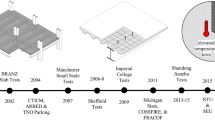Abstract
Finding the geometry and properties of a ceramic tile after its firing using simulations, is relevant because several defects can occur and the tile can be rejected if the conditions of the firing are inadequate for the geometry and materials of the tile. Previous works present limitations because they do not use a model characteristic of ceramics at high temperatures and they oversimplify the simulations. As a response to such shortcomings, this article presents a simulation with a three-dimensional Norton’s model, which is characteristic of ceramics at high temperatures. The results of our simulated experiments show advantages with respect to the identification of the mechanisms that contribute to the final shape of the body. Our work is able to divide the history of temperatures in stages where the evolution of the thermal, elastic, and creep deformations is simplified and meaningful. That is achieved because our work found that curvature is the most descriptive parameter of the simulation. Future work is to be realized in the creation of a model that takes into account that the shrinkage is dependent on the history of temperatures.








Similar content being viewed by others
Abbreviations
- \( H(S,p) \) :
-
Mean curvature of a surface S at a point p
- \( H_{\text{upp}} \) :
-
Set of discrete mean curvatures at the nodes of the upper face of the ceramic tile
- \( H_{\text{low}} \) :
-
Set of discrete mean curvatures at the nodes of the lower face of the ceramic tile
- \( \upvarepsilon_{\text{th}} \) :
-
Set of thermal strains in one direction. Von Misses thermal strains are not defined
- \( V\upvarepsilon_{\text{el}} \) :
-
Set of Von Mises elastic strains
- \( V\upvarepsilon_{\text{cr}} \) :
-
Set of Von Mises creep strains
- \( V\upsigma \) :
-
Set of Von Mises stresses
- \( \overline{M} \) :
-
Average of set M. The set can be: \( H_{\text{low}} , H_{\text{upp}} , \upvarepsilon_{\text{th}} , V\upvarepsilon_{\text{cr}} , V\upvarepsilon_{\text{el}} , \) or \( V\upsigma \)
- \( {\text{std}}. {\text{dev}}. M \) :
-
Standard deviation of set M
- \( { \max }\left( M \right) \) :
-
Maximum absolute value of set M
- \( \upsigma_{1} , \upsigma_{2} ,\upsigma_{3} \) :
-
Set of first principal, second principal, and third principal stresses, respectively
References
ISO. 10545-2:1995, “Ceramic Tiles—Part 2: Determination of Dimensions and Surface Quality,” International Standard Confirmed, International Organization for Standardization, Geneva, Switzerland, 31 Dec 2005
M. Botsch and M. Pauly. Course 23: Geometric Modeling Based on Polygonal Meshes, ACM SIGGRAPH 2007 Courses, 2007
E.A. Olevsky and V. Tikare, Combined Macro-Meso Scale Modeling of Sintering. Part I: Continuum Approach, Recent Developments in Computer Modeling of Powder Metallurgy Processes, A. Zavaliangos and A. Laptev, Ed., IOS Press, Amsterdam, The Netherlands, 2001, p 85
V. Tikare, E.A. Olevsky, and M.V. Braginsky, Combined Macro-Meso Scale Modeling of Sintering. Part II, Mesoscale Simulations, Recent Developments in Computer Modeling of Powder Metallurgy Processes, A. Zavaliangos and A. Laptev, Ed., IOS Press, Amsterdam, The Netherlands, 2001, p 94
K. Shinagawa, Finite Element Simulation of Sintering Process: Microscopic Modelling of Powder Compacts and Constitutive Equation for Sintering, JSME Int J., Ser. A, 1996, 39(4), p 565–572
H. Riedel and T. Kraft, Numerical Simulation of Solid State Sintering: Model and Application, J. Eur. Ceram. Soc., 2004, 24, p 345–361
H. Riedel and B. Blug, A Comprehensive Model for Solid State Sintering and Its Application to Silicon Carbide, Solid Mech. Appl., 2001, 84, p 49–70
J.A. Yeomans, M. Barriere, P. Blanchart, S. Kiani, and J. Pan, Finite Element Analysis of Sintering Deformation Using Densification Data Instead of a Constitutive Law, J. Eur. Ceram. Soc., 2007, 27, p 2377–2383
H. Su and D.L. Johnsonn, Master Sintering Curve: A Practical Approach to Sintering, J. Am. Ceram. Soc., 1996, 79(12), p 3211–3217
H. Camacho, M.E. Fuentes, L. Fuentes, A. Garcia, and A. Perez, Stress Distribution Evolution in a Ceramic Body During Firing. Part 1. Problem Statement, Bol. Soc. Esp. Ceram., 2003, 42, p 283–288
H. Camacho, M.E. Fuentes, L. Fuentes, A. Garcia, and A. Perez, Stress Distribution Evolution in a Ceramic Body During Firing. Part 2. Profile Calculation, Bol. Soc. Esp. Ceram., 2003, 42, p 353–359
V. Cantavella Soler, et al., “Simulación de la deformación de baldosas cerámicas durante la cocción,” PhD thesis, 1998
W.R. Cannon and T.G. Langdon, Review: Creep of Ceramics. Part 1: Mechanical Characteristics, J. Mater. Sci., 1983, 18(1), p 1–50
W.R. Cannon and T.G. Langdon, Review: Creep of Ceramics. Part 2: An Examination of Flow Mechanisms, J. Mater. Sci., 1988, 23, p 1–20
M. Mitchell. Engauge Digitizer, 2009
R Development Core Team, R: A Language and Environment for Statistical Computing, R Foundation for Statistical Computing, Vienna, Austria, 2009, ISBN 3-900051-07-0
G. Grothendieck, nls2: Non-linear Regression with Brute Force, R package version 0.1-2, 2007
J. Swanson, Ansys 11.0, Ansys, 2008
J.L. Amoros, E. Sanchez, V. Cantavella, and J.C. Jarque, Evolution of the Mechanical Strength of Industrially Dried Ceramic Tiles During Storage, J. Eur. Ceram. Soc., 2003, 23(11), p 1839–1845
Author information
Authors and Affiliations
Corresponding author
Rights and permissions
About this article
Cite this article
Peris-Fajarnés, G., Defez, B., Serrano, R. et al. Simulation of the Evolution of Floor Covering Ceramic Tiles During the Firing. J. of Materi Eng and Perform 22, 936–942 (2013). https://doi.org/10.1007/s11665-012-0354-5
Received:
Revised:
Published:
Issue Date:
DOI: https://doi.org/10.1007/s11665-012-0354-5




